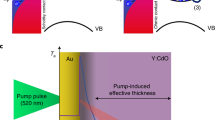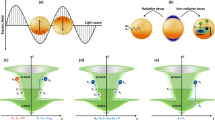Abstract
Non-equilibrium hot carriers formed near the interfaces of semiconductors or metals play a crucial role in chemical catalysis and optoelectronic processes. In addition to optical illumination, an efficient way to generate hot carriers is by excitation with tunnelling electrons. Here, we show that the generation of hot electrons makes the nanoscale tunnel junctions highly reactive and facilitates strongly confined chemical reactions that can, in turn, modulate the tunnelling processes. We designed a device containing an array of electrically driven plasmonic nanorods with up to 1011 tunnel junctions per square centimetre, which demonstrates hot-electron activation of oxidation and reduction reactions in the junctions, induced by the presence of O2 and H2 molecules, respectively. The kinetics of the reactions can be monitored in situ following the radiative decay of tunnelling-induced surface plasmons. This electrically driven plasmonic nanorod metamaterial platform can be useful for the development of nanoscale chemical and optoelectronic devices based on electron tunnelling.
This is a preview of subscription content, access via your institution
Access options
Access Nature and 54 other Nature Portfolio journals
Get Nature+, our best-value online-access subscription
$29.99 / 30 days
cancel any time
Subscribe to this journal
Receive 12 print issues and online access
$259.00 per year
only $21.58 per issue
Buy this article
- Purchase on Springer Link
- Instant access to full article PDF
Prices may be subject to local taxes which are calculated during checkout




Similar content being viewed by others
References
Lambe, J. & McCarthy, S. L. Light emission from inelastic electron tunneling. Phys. Rev. Lett. 37, 923–925 (1976).
Schneider, N. L., Schull, G. & Berndt, R. Optical probe of quantum shot-noise reduction at single-atom contact. Phys. Rev. Lett. 105, 026601 (2010).
Bharadwaj, P., Bouhelier, A. & Novotny, L. Electrical excitation of surface plasmons. Phys. Rev. Lett. 106, 226802 (2011).
Dong, Z. G. et al. Electrically-excited surface plasmon polaritons with directionality control. ACS Photon. 2, 385–391 (2015).
Du, W. et al. On-chip molecular electronic plasmon sources based on self-assembled monolayer. Nat. Photon. 10, 274–280 (2016).
Kern, J. et al. Electrically driven optical antennas. Nat. Photon. 9, 582–586 (2015).
Parzefall, M. et al. Antenna-coupled photon emission from hexagonal boron nitride tunnel junctions. Nat. Nanotech. 10, 1058–1063 (2015).
Bigourdan, F., Hugonin, J.-P., Marquier, F., Sauvan, C. & Greffet, J.-J. Nanoantenna for electrical generation of surface plasmon polaritons. Phys. Rev. Lett. 116, 106803 (2016).
Clavero, C. Plasmon-induced hot-electron generation at nanoparticle/metal-oxide interfaces for photovoltaic and photocatalytic devices. Nat. Photon. 8, 95–103 (2014).
Brongersma, M. L., Halas, N. J. & Nordlander, P. Plasmon-induced hot carrier science and technology. Nat. Nanotech. 10, 25–34 (2015).
Harutyunyan, H. et al. Anomalous ultrafast dynamics of hot plasmonic electrons in nanostructures with hot spots. Nat. Nanotech. 10, 770–774 (2015).
Mubeen, S. et al. An autonomous photosynthetic device in which all charge carriers derive from surface plasmons. Nat. Nanotech. 8, 247–251 (2013).
Mukherjee, S. et al. Hot electrons do the impossible: plasmon-induced dissociation of H2 on Au. Nano Lett. 13, 240–247 (2013).
Christopher, P., Xin, H. L. & Linic, S. Visible-light-enhanced catalytic oxidation reactions on plasmonic silver nanostructures. Nat. Chem. 3, 467–472 (2011).
Kumar, A., Kumar, S., Rhim, W.-K., Kim, G.-H. & Nam, J.-M. Oxidative nanopeeling chemistry-based synthesis and photodynamic and photothermal therapeutic applications of plasmonic core-petal nanostructures. J. Am. Chem. Soc. 136, 16317–16325 (2014).
Zhai, Y. M. et al. Polyvinylpyrrolidone-induced anisotropic growth of gold nanoprisms in a plasmon-driven synthesis. Nat. Mater. 15, 889–895 (2016).
Knight, M. W., Sobhani, H., Nordlander, P. & Halas, N. J. Photodetection with active optical antennas. Science 332, 701–704 (2011).
Govorov, A. O. & Richardson, H. H. Generating heat with metal nanoparticles. Nano Today 2, 30–38 (2007).
Lock, D., Rusimova, K. R., Pan, T. L., Palmer, R. E. & Sloan, P. A. Atomically resolved real-space imaging of hot electron dynamics. Nat. Commun. 6, 8365 (2015).
Albrecht, T. Electrochemical tunnelling sensors and their potential applications. Nat. Commun. 3, 829 (2012).
Wang, D. D. et al. Tuning the tunneling rate and dielectric response of SAM-based junctions via a single polarizable atom. Adv. Mater. 27, 6689–6695 (2015).
Kabashin, A. V. et al. Plasmonic nanorod metamaterials for biosensing. Nat. Mater. 8, 867–871 (2009).
Nasir, M. E., Dickson, W., Wurtz, G. A., Wardley, W. P. & Zayats, A. V. Hydrogen detected by the naked eye: optical hydrogen gas sensors based on core/shell plasmonic nanorod metamaterials. Adv. Mater. 26, 3532–3537 (2014).
Yakovlev, V. V. et al. Ultrasensitive non-resonant detection of ultrasound with plasmonic metamaterials. Adv. Mater. 25, 2351–2356 (2013).
Atkinson, R. et al. Anisotropic optical properties of arrays of gold nanorods embedded in alumina. Phys. Rev. B 73, 235402 (2006).
Vasilantonakis, N., Nasir, M. E., Dickson, W., Wurtz, G. A. & Zayats, A. V. Bulk plasmon-polaritons in hyperbolic nanorod metamaterial waveguides. Lasers Photon. Rev. 9, 345–353 (2015).
Simmons, J. G. Generalized formula for the electric tunnel effect between similar electrodes separated by a thin insulating film. J. Appl. Phys. 34, 1793–1803 (1963).
Johansson, P. Light emission from a scanning tunneling microscopy: fully retarded calculation. Phys. Rev. B 58, 10823–10834 (1998).
Downes, A., Taylor, M. E. & Welland, M. E. Two-sphere model of photon emission from the scanning tunneling microscope. Phys. Rev. B 57, 6706–6714 (1998).
Manjavacas, A., Liu, J. G., Kulkarni, V. & Nordlander, P. Plasmon-induced hot carriers in metallic nanoparticles. ACS Nano 8, 7630–7638 (2014).
Zhao, L. –B. et al. Theoretical study of plasmon-enhanced surface catalytic coupling reactions of aromatic amines and nitro compounds. J. Phys. Chem. Lett. 5, 1259–1266 (2014).
Hahn, J. R., Jang, S. H., Kim, K. W. & Son, S. B. Hot carrier-selective chemical reactions on Ag(110). J. Chem. Phys. 139, 074707 (2013).
Canning, N. D. S., Outka, D. & Madix, R. J. The absorption of oxygen on gold. Surf. Sci. 141, 240–254 (1984).
Huang, Y.-F. et al. Activation of oxygen on gold and silver nanoparticles assisted by surface plasmon resonances. Angew. Chem. Int. Ed. 53, 2353–2357 (2014).
Huang, Y.-F., Zhu, H.-P., Liu, G.-K., Ren, B. & Tian, Z.-Q. When the signal is not from the original molecule to be detected: chemical transformation of para-aminothiophenol on Ag during the SERS measurement. J. Am. Chem. Soc. 132, 9244–9246 (2010).
Zhao, L.-B. et al. Surface plasmon catalytic aerobic oxidation of aromatic amines in metal/molecule/metal junctions. J. Phys. Chem. C 120, 944–955 (2016).
Yalon, E., Riess, I. & Ritter, D. Heat dissipation in resistive switching devices: comparison of thermal simulations and experimental results. IEEE Trans. Electron. Devices 61, 1137–1144 (2014).
Davis, M. E. & Davis, R. J. Fundamentals of Chemical Reaction Engineering (McGraw Hill, New York, 2003).
Adleman, J. R., Boyd, D. A., Goodwin, D. G. & Psaltis, D. Heterogenous catalysis mediated by plasmon heating. Nano Lett. 9, 4417–4423 (2009).
Mukherjee, S. et al. Hot-electron-induced dissociation of H2 on gold nanoparticles supported on SiO2. J. Am. Chem. Soc. 136, 64–67 (2014).
Sil, D. et al. Seeing is believing: hot electron based gold nanoplasmonic optical hydrogen sensor. ACS Nano 8, 7755–7762 (2014).
Pfisterer, J. H. K., Liang, Y. C., Schneider, O. & Bandarenka, A. S. Direct instrumental identification of catalytically active surface sites. Nature 549, 74–77 (2017).
Chalabi, H., Schoen, D. & Brongersma, M. L. Hot-electron photodetection with a plasmonic nanostripe antenna. Nano Lett. 14, 1374–1380 (2014).
Aradhya, S. V. & Venkataraman, L. Single-molecule junctions beyond electronic transport. Nat. Nanotech. 8, 399–410 (2013).
Rendell, R. W. & Scalapino, D. J. Surface plasmons confined by microstructures on tunnel junctions. Phys. Rev. B 24, 3276–3294 (1981).
Acknowledgements
This work has been funded in part by the Engineering and Physical Sciences Research Council (UK) and the European Research Council iPLASMM project (321268). A.V.Z. acknowledges support from the Royal Society and the Wolfson Foundation. The authors thank W. P. Wardley for helpful discussion.
Author information
Authors and Affiliations
Contributions
A.V.Z. and P.W. conceived the study. P.W. constructed the experiment, performed the measurement and analysed the data. M.E.N. and W.D. fabricated the plasmonic nanorod metamaterials. A.V.K. performed numerical simulations. All the authors discussed the results and co-wrote the paper.
Corresponding authors
Ethics declarations
Competing interests
The authors declare no competing financial interests.
Additional information
Publisher’s note: Springer Nature remains neutral with regard to jurisdictional claims in published maps and institutional affiliations.
Supplementary information
Supplementary Information
Supplementary Figures 1–12.
Rights and permissions
About this article
Cite this article
Wang, P., Krasavin, A.V., Nasir, M.E. et al. Reactive tunnel junctions in electrically driven plasmonic nanorod metamaterials. Nature Nanotech 13, 159–164 (2018). https://doi.org/10.1038/s41565-017-0017-7
Received:
Accepted:
Published:
Issue Date:
DOI: https://doi.org/10.1038/s41565-017-0017-7
This article is cited by
-
On-chip ultrasensitive and rapid hydrogen sensing based on plasmon-induced hot electron–molecule interaction
Light: Science & Applications (2023)
-
Nanoplasmonic amplification in microfluidics enables accelerated colorimetric quantification of nucleic acid biomarkers from pathogens
Nature Nanotechnology (2023)
-
Plasmon assisted tunnelling through silver nanodisk dimer‐optical properties and quantum effects
Optical and Quantum Electronics (2021)
-
Gold Nanozymes: From Concept to Biomedical Applications
Nano-Micro Letters (2021)
-
Optical probes of molecules as nano-mechanical switches
Nature Communications (2020)



